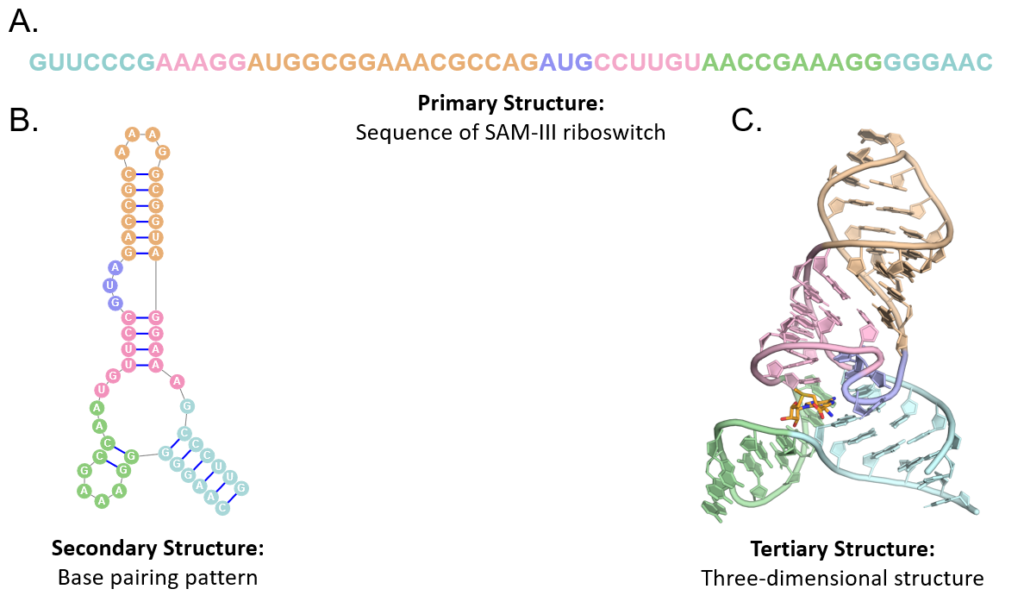by Seth Veenbaas
You may already know that DNA is a complex molecule in all our cells that stores genetic information. We get our DNA from our parents and it contains all the genes (or instructions) our bodies need to grow and stay alive. DNA and genetics are important parts of biology and are increasingly becoming important references in our culture (Fig. 1). You may have even heard sports fans referencing that, “being a Tar Heel is in their DNA.” So if DNA is such an essential component in shaping who we are, then what is RNA, and what role does it play in our biology?
You can think of DNA and RNA as brothers. Both DNA and RNA are nucleic acids, long chains made of smaller nucleotide building blocks. The nucleotides that make up DNA and RNA are very similar and only differ by a single oxygen atom. However, this small difference in their structures is enough to make each of them better at performing their specific jobs inside cells. DNA stores a permanent record of our genetic information within the protection of the cell nucleus. DNA segments called genes are copied into RNA molecules in a process called transcription. Some of these RNA copies are called messenger RNAs (mRNA) and leave the safety of the nucleus to carry genetic messages throughout the rest of the cell. Often the messages carried by mRNA are instructions for making proteins. The process that describes this flow of information from DNA to RNA and RNA to proteins is called the central dogma of biology (Fig. 2).
RNAs have many structural levels important in defining their role in cells (Fig. 3A). RNAs can carry messages because of their primary structure which is nearly identical to DNA. The primary structure of RNA is the order, or sequence, of nucleotide building blocks that compose the RNA strand. The four unique nucleotide building blocks in RNA are abbreviated as A, C, G, and U. RNAs are not just long, flappy strings of letters though — they can also form more complex structures. RNA secondary structure is formed when nucleotides bind to each other to form double-stranded regions (Fig. 3B). This creates structural dimensionality because nucleotides very far away from each other in the primary structure can be paired together in the secondary structure. Lastly, many RNAs can also fold to make complex three-dimensional shapes called tertiary structures (Fig. 3C). (Break out your 3D glasses!)

The structural complexity and diversity of RNAs allow them to do more than just carry messages within the cell. RNAs can be split into two broad categories: coding and noncoding. Messenger RNAs, discussed earlier for their role in the central dogma of biology, are coding RNAs because their primary structures encode instructions for making proteins. However, non-coding RNAs do not carry messages within the cell. Instead, the complex secondary and tertiary structures of non-coding RNAs allow them to function similarly to proteins. For example, two types of non-coding RNAs are essential parts of the ribosome. Ribosomes are very important because they are the cell’s main protein-building factories. Transfer RNAs (tRNA) deliver amino acids to the ribosome in the correct order to make proteins, while Ribosomal RNAs (rRNAs) are the primary component of the ribosome. rRNAs are ribozymes (enzymes made of RNA) that catalyze the chemical reactions that link small amino acids into long chains of protein. Together, three types of RNA work together to carry (mRNA), read (tRNA), and execute (rRNA) the instructions for making a protein in a process called translation (Fig. 4).
Ribosomal and transfer RNAs are the most prevalent types of RNA in cells but there are also other types of RNA. Some other types of RNA are microRNAs (miRNA), small interfering RNAs (siRNA), and riboswitches which all allow cells to control how much protein to make. You can read more about all of these cool regulatory RNAs and some other types of non-coding RNA at Scitable.
RNA is an essential molecule in every living organism that can carry genetic messages from our DNA throughout the cell. Additionally, RNAs can also perform important cellular functions like making and regulating the creation of proteins. The ability of RNA to perform a wide variety of roles within the cell is possible because of the multiple layers of RNA structure and makes RNA a unique molecule. So next time you hear someone say “It’s in my DNA,” remember that it is also in their RNA.
